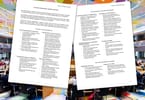Almost 454,000 visitors were recorded in the financial year 2008/9, which ended on June 20, 2009, entering the fabled Ngorongoro Crater in northern Tanzania, earning TANAPA about 34 billion Tanzania shillings through park fees and permits. However, in the first half of this financial year, i.e., the period of July 1 until December 31, 2009, over 260,000 tourists have already visited the crater area, bringing the half year earnings to over 25 billion Tanzania shillings.
With a new visitor record now in the making – it is estimated that about 550,000 visitors will come to Ngorongoro this financial year – other voices are gathering momentum about the sustainability of ever greater numbers of vehicles and visitors going into the crater’s caldera. This is clearly reviving talk of yesteryear to eventually cap the number of visitors permitted to enter, if other measures continue to fail in restricting added arrivals.
As demand grows again, and likely keeps growing as the global economy recovers, this is probably only achievable over raised entrance and permit fees, similar to how the permits for mountain gorilla trekking are managed in Rwanda and Uganda.
No number of maximum visitors has however emerged yet and is likely to remain a matter of intense discussions and consultations between conservationists, TANAPA management, and tourism stakeholders, the latter in particular concerned about ever rising cost of their safaris already.
It was also learned that key staff of the Ngorongoro Conservation Area Authority expressed doubts if raised prices alone would help them to put a cap on numbers, as tariff increases in the past were easily absorbed by the safari operators through raising their package costs. Hence, the discussion is indeed now on about how best to proceed from here on, in order to avoid ever more cars making their way into the crater, estimated already to be high in the 400 count when the lodges on the crater’s rim are fully booked.
The debate about the Ngorongoro Conservation Area was further spiced up when last week calls emerged to amend the governing law and permit all Tanzanians equal access as demanded by the country’s constitution, as presently only Masai and their livestock are permitted to reside inside the conservation area. However, the number of people entitled by law to live there has skyrocketed in recent decades and livestock, too, has reached numbers which conservationists think unsustainable for the fragile environment, prompting added arguments and discussions of how best to proceed, catering for both the conservation aspects but also the Masai who for time immemorial have been living on and from the land of their forebears.
To compound matters further for the Masai living in the conservation area, some members of parliament, too, have now called to dial back the residencies, which were initially meant to cater for only up to 25,000 Masai while the current number appears to have risen to over 60,000 already, unsustainable as one source in Arusha called it when discussing the issue with this correspondent. Challenging times ahead for the conservation fraternity, tourism stakeholders, and local communities.
WHAT TO TAKE AWAY FROM THIS ARTICLE:
- To compound matters further for the Masai living in the conservation area, some members of parliament, too, have now called to dial back the residencies, which were initially meant to cater for only up to 25,000 Masai while the current number appears to have risen to over 60,000 already, unsustainable as one source in Arusha called it when discussing the issue with this correspondent.
- Hence, the discussion is indeed now on about how best to proceed from here on, in order to avoid ever more cars making their way into the crater, estimated already to be high in the 400 count when the lodges on the crater's rim are fully booked.
- However, the number of people entitled by law to live there has skyrocketed in recent decades and livestock, too, has reached numbers which conservationists think unsustainable for the fragile environment, prompting added arguments and discussions of how best to proceed, catering for both the conservation aspects but also the Masai who for time immemorial have been living on and from the land of their forebears.






















